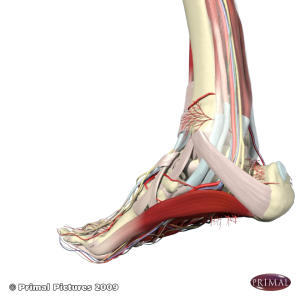Audience: Therapists
 Functional Hallux Limitis (FHL) is a decrease in the dorsiflexion of the big toe during gait. This limitation is assumed to be “functional” and is not structural. This means that simply pushing the big toe into dorsiflexion will not identify whether there is a functional problem.
Functional Hallux Limitis (FHL) is a decrease in the dorsiflexion of the big toe during gait. This limitation is assumed to be “functional” and is not structural. This means that simply pushing the big toe into dorsiflexion will not identify whether there is a functional problem.
This lack of dorsiflexion of the 1st MTP joint can be associated with a lack of plantar flexion of the 1st metatarsal (i.e. the 1st metatarsal may be hypermobile in that it translates/rotates dorsally) .
Howard Dananberg has written and theorized extensively on the topic and I believe he is credited with postulating how limitation in big toe dorsiflexion can have negative effects right up the kinetic chain culminating in low back dysfunction. (editors note: the following of how FHL influences ground contact time is wrong - wow, I was taught this years ago and still hear it . Dr. Dananberg wrote to correct me. I have stroked out what my original comment was and italicized the corrected version. However, my inaccuracy does not change what theoretically happens at the hip which is what I was most interested in. His comment is below) Very simply, Dr. Dananberg suggests that a limited big toe dorsiflexion results in a too early toe off (because the foot can’t stay on the ground long enough because of the lack dorsiflexion). This early toe . FHL may lead to a prolonged time to when the heel is raised off the ground. The prolonged ground contact may then leads to prolonged periods of flat foot. This abnormal function may lead to a decrease in hip extension which may cause the psoas and iliacus to actively fire to a greater degree than they would have had they been stretched with normal hip extension (i.e. a decrease in the elastic strain energy storage in the soft tissue structures anterior to the hip joint). I stress the use of the word “may” - While I greatly appreciate this theory and respect the thinking and work behind it I can’t find any biomechanical work (e.g. a kinematic analysis correlating these altered kinematics to one another and the Fhl) to support it.
THE PROBLEM - CAN WE IDENTIFY FHL?
Whether a FHL is related to more proximal pathology can certainly be debated and part of debating and testing its influence on sagital plane dysfunction requires us to be able to identify FHL in our patients. Fortunately, Halstead and Raymond (JOSPT 2006) aimed to determine if there was a relationship between a static weightbearing assessment of 1st MTP dorsiflexion (the Hubscher test) and the amount of dorsiflexion that occurred during walking. The test had subjects stand on both feet while the experiment lifted up (dorsiflexed) their big toe to its maximal amount. Interestingly, they also did a similar test but in non-weight bearing where people were excluded from the study if their non-weightbearing dorsiflexion values were less than 50 degrees (i.e. they had a structural limitation of MTP dorsiflexion).
The authors put subjects into two groups: the first group was limited in their static weightbearing dorsiflexion (about 19 degrees) and the control group had normal dorsiflexion during the static weight bearing test (about 39 degrees). Remember, both groups had full dorsiflexion when tested in non-weightbearing (about 55 degrees).
What did they find?
Snap! No relationship. I am getting a little tired of the weakness of our clinical tests. The average dorsiflexion of the MTP during walking was about 36 degrees in both groups with a poor relationship between the static measure and the dynamic measure in the group that had lower MTP dorsiflexion values in the static test.
The authors make the following conclusion:
“We consider the underlying assumptions required for inferring dynamic function from the Hubscher maneuver to be invalid, and we suggest that the term FHL can only be applied using an instrumented dynamic gait assessment to confirm first MTP joint limitation during walking. The data indicate that the Hubscher maneuver is an inappropriate basis for treatment decisions and cannot be considered valid as an outcome measure for other functional therapy”
TAKE HOME POINTS
1. Other tests for FHL may be more appropriate (have patients do a calf raise, observe for a pinch callus on the medial aspect of the first ray and toe)
2. FHL can exist but we may have no means of testing it clinically
My Thoughts
1. There is still a paucity of research investigating how limits in big toe dorsiflexion influence sagital plane kinematics (toe off, knee angles, hip extension, spinal bend). This research is not difficult it just has not been done.
2. For manual therapists we don’t know with certainty what structures are involved in FHL. Again, a simple study looking at sagital plane kinematics pre and post the treatment of different structures would provide a starting point.
3. With the 1st metatarsal hypermobility being linked with FHL us manual therapists may want to be judicious in how much we manipulate and mobilize.
4. Why do I keep reading/hearing that the 1st toe needs 65 degrees of dorsiflexion during gait. I think this is wrong as it appears to be more in line with 30-40 degrees. Nawoczenski (1999) supports this as does the study reviewed above. I would also hazard that more dorsiflexion is not required during running much as more hip extension is not seen during running when compared to walking.
Adios,
Greg Lehman




Greg,
I was forwarded your article by a physical therapist colleague. It would seem from your writing that the concept of Functional hallux limitus (Fhl) and its effect on gait has eluded your grasp. You wrote “Very simply, Dr. Dananberg suggests that a limited big toe dorsiflexion results in a too early toe off (because the foot can’t stay on the ground long enough because of the lack dorsiflexion). “ If anything, Fhl causes a delay in heel lift and prolonged periods of ground contact, as the pivotal site about which the heel raises during gait is restricted. It is this effect which then creates the cascade of events which lead to the repetitive strain effect on the foot, lower extremity and lumbar spine.
Think about human gait as follows. Humans pull to move. The power is dictated by the swing limb. By stepping forward, the CoM is destabilized in the anterior direction. As gravity acts on the CoM, it is functionally pulled towards the support surface, passing over the weight bearing limb in the process. The MTP joints are the pivotal site which permit the heel to raise while the forefoot remains in ground contact. CoM is therefore capable of advancing beyond the weight bearing foot while the weight bearing lower extremity extends at the hip. When the MTP joint dorsiflexes, it activates the windlass effect, and self support ensues.
Now, imagine walking in swim fins. The extension at the end of the toes blocks any meaningful heel lift, and a steppage type, high energy cost gait style results. Toe off is not early, but rather heel lift is delayed, and prolonged periods of foot flat exist. This is the Fhl effect.
You were correct in that Fhl is a functional disorder. The only way MTP joint motion is visible during the single support phase is by virtue of the heels lifting and pivoting over the metatarsal heads. If normal or even hypermobile 1st MTP joint motion exists on non-weight bearing clinical exam, it is no wonder that this has been missed as a clinical entity, and most often misunderstood as a major pathologic disturbance of gait efficiency.
Any clinical test for Fhl has its inaccuraciesCraig Payne has actually studied this in the past. “The test had a sensitivity of 0.72 and a specificity of 0.66, suggesting that clinicians should consider functional hallux limitus when there is late midstance pronation of the midtarsal joint during gait.” Considering it is a clinical tool, and not an absolute, then it certainly has value in a manual practice. . I prefer having the patient seated, and the load the 1st met head (push into dorsiflexion) and then try to dorsiflex the hallux. Even minor restrictions or increased compliance can give the clinician an indication that this exists.
Craig Payne, DipPod, MPH*, Vivienne Chuter, BPod(Hons) and Kathryn Miller, BPod, Sensitivity and Specificity of the Functional Hallux Limitus Test to Predict Foot Function, Journal of the American Podiatric Medical Association Volume 92 Number 5 269-271 2002
You did comment on limited papers on this subject regarding hip ROM and other postural symptoms. I have included the following references.
Dananberg, HJ, “Gait Style and Its Relevance in the Management of Chronic Lower Back Pain”, In Proceedings, 4th Interdisciplinary World Congress of Low Back & Pelvic Pain”, Ed, Vleeming, A, Mooney. V, Gracovetsky, S, Lee, D, etal, November 8-10, 2001, pp 225-230
(This paper evaluated the ROM of the hip joint at the termination of single support phase in subjects diagnosed with Fhl and treated with custom foot orthotics designed to treat. The pre-treatment average ROM was 7.5 degrees and post treatment was 13 degrees.)
Dananberg, HJ, Guiliano, M, “Chronic Lower Back Pain And It Response to Custom Foot Orthoses”, Journal of the American Podiatric Medical Association, 89:3 March, 1999 pp109-117
(This paper reviewed 32 patients considered at medical endpoint for CLBP who were treated with lower extremity manipulation for ankle equines and then dispensed custom foot orthotics designed to treat Fhl. Pain levels were assessed using the Quebec Back Pain Disability Rating. Patients were assessed prior to treatment, at 3 months, and then at 12-24 months with an average f/u time of 13.5 months. 84% of subjects showed improvement at more than 2x’s the level of standard care measures, with subjects having virtually no increase in symptoms between 3 and 12-24 months post treatment. )
As a manual therapist, you alluded to avoidance of manipulation of the 1st MTP joint when hypermobility exists. I would agree. I would suggest, however, that the area which can be examined in this case is peroneus longus facilitation vs. inhibition. Loss of apparent p. longus muscle strength prevents 1st metatarsal stabilization against the ground force which dorsiflexes it. Inhibition of the p. longus is very common and is best managed by fibula and ankle joint manipulation. Reference is below. Dananberg, HJ, Shearstone, J, Guiliano, M “Manipulation Method for the Treatment of Ankle Equinus, “ Journal of the American Podiatric Medical Association, 90:8 September, 2000 pp 385-389
Howard Dananberg, DPM
Bedford, NH
[...] Having “instability” or too much movement of the 1st metatarsal (e.g. it dorsiflexes) does not allow the the MTP to dorsiflex. Therefore, you need stability at this joint for mobility to occur. Therefore the assumed deficit is a lack of mobility whereas the actual tendency towards dysfunction is a lack of stability. The perceived dysfunction at this joint is termed functional hallucis limitis and has been questioned by many biomechanists. See a review here. [...]